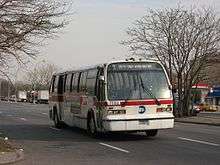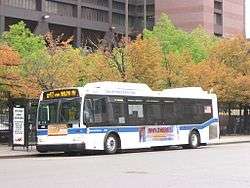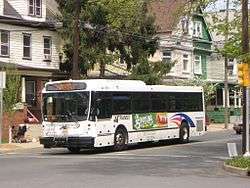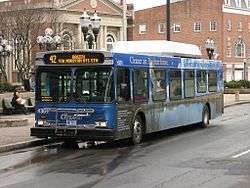Triboro Coach
Triboro Coach Corporation was a bus company in New York City, United States, operating local service in Queens and express routes to Manhattan until February 20, 2006.
History

Salvatore Fornatora began operating buses in Queens in April 1919 as the Woodside-Astoria Transportation Company,[1] with his first route (part of today's Q19 route) connecting 103rd Street-Corona Plaza on the recently opened Corona Line in Corona with Flushing. In 1928 the Corona terminal was extended westward, and moved to Astoria - 21st Street, when the Corona Line was extended to Flushing, and the company was also operating several other routes in the Astoria-Woodside-Maspeth area by 1930.
The new Triboro Coach Corporation was incorporated on April 10, 1931,[1] running the Q18 and Q24 routes. On September 24, 1936 it acquired a city franchise for nine routes in northwestern Queens (the "Long Island City zone").[1][2] After World War II, Triboro was acquired by the stockholders of Green Bus Lines, after financial difficulties, but continued to operate independently.[1] Its depot in East Elmhurst was opened on January 15, 1954.[3] Major expansions were made in 1956 with an express bus route (now the Q53) between Woodside and Rockaway Park (replacing the Long Island Rail Road's Rockaway Beach Branch, out of service since 1950) and in 1961, when it acquired the Q72 (then the B72) from the New York City Transit Authority. Five express routes to Manhattan were initiated in the 1970s and 1980s: the QM10 & QM11 in 1970, QM12 in 1971, and QM22, QM24, and QM24W in June 1988. Triboro was the first private company in the city to initiate express operations with the Q53 Woodside-Rockaway Park Express bus line in 1956, at the request of the City of New York due to the loss of direct LIRR Rockaway service from Woodside.[1][4][5][6][7]
In addition to diesel powered buses, Triboro housed a Methanol, and compressed natural gas (CNG) fueling facility, along with several CNG powered buses at its final facility in East Elmhurst. The methanol fuel station was installed in 1989 for six General Motors-built methanol buses.[8] In the early 1990s, three Triboro-operated RTS buses were fitted with special Detroit Diesel Series 92 engines that ran on methanol provided by Air Products & Chemicals.[9] CNG fueling was installed in 1994 to be used for orders of TMC RTS-06 CNG buses and later Orion V CNG buses that were ordered in conjunction with identical buses used by Command Bus Company and Queens Surface Corporation (now Spring Creek Depot and College Point Depot respectively).[10]
On February 2, 2006, the operations of Triboro Coach were taken over by the Metropolitan Transportation Authority (MTA) under the MTA Bus Company brand, part of the city's takeover of all the remaining privately operated bus routes.[1][11][12] As part of the takeover, the former Triboro Coach garage became the LaGuardia Depot.[11] However, the facility was severely damaged in April 2006 (only 2 months after the MTA Takeover) following an explosion within one of the natural gas lines and destroyed a former Triboro/ ex-Jamaica Bus RTS-04 (see below).[13] All of the ex-Triboro CNG buses were transferred to Spring Creek and College Point Depots and ran from there up until their retirement.
Bus routes
.jpg)
Just prior to MTA Bus takeover, Triboro Coach operated the following routes. Most of these continue to be based out of the company's former facility in East Elmhurst.[14]
- Q18 Astoria - Maspeth, via 30th Avenue (Formerly Steinway Transit Corporation Flushing Line; Q18 Astoria-Woodside and Q24 Woodside-Maspeth; combined into Q18)
- Q19 Astoria - Flushing, via Astoria Boulevard
- Q19A (Now Q69) Long Island CIty - East Elmhurst/Jackson Heights via 21st Street & Ditmars Boulevard.
- Q19B (Now Q49) Jackson Heights - East Elmhurst via 35th Avenue
- Q23 East Elmhurst - Forest Hills via 108th Street (acquired in 1936 from North Shore Bus Company)
- Q29 Jackson Heights - Glendale via 80th Street (acquired in 1936 from Kings Coach Company)
- Q33 Jackson Heights - LaGuardia Airport Central Terminal (acquired in 1936 from Municipal Motorbus Company) via 82nd/83rd Streets (Since shortened due to new Q70 bus to LaGuardia airport)
- Q38 Eliot and Penelope Avenues (acquired in 1936 from Affiliated Bus Transit Corporation)
- Q39 Long Island City - Ridgewood, via Forest Avenue (acquired in 1936 from National City Bus Lines)
- Q45 Jackson Heights - Juniper Valley via 69th Street (combined into current Q47 route on September 4, 2011)
- Q47 Jackson Heights - LaGuardia Airport Marine Air Terminal via 69th Street and 80th Street (now including former Q45)
- Q53 Woodside - Rockaway Park Express (established in the 1950s)
- Q72 East Elmhurst/LaGuardia Airport - Rego Park via Junction Boulevard (acquired in 1961 from New York City Transit Authority)
- QM10 Lefrak City Express via 6th Avenue or 3rd Avenue
- QM11 Forest Hills - LeFrak City - Wall Street
- QM12 Forest Hills Express via 6th Avenue or 3rd Avenue
- QM22 Jackson Heights Express via 6th Avenue or 3rd Avenue (discontinued in 2010)
- QM24 Glendale Express via 8th Avenue
- QM24 (Now QM34) Glendale Express via 3rd Avenue
- QM24W (Now QM25) Glendale - Wall Street Express
Depots
Astoria depot
The company's first garage was located at 29-28 Vernon Boulevard[15] or 23-29/29-23 Vernon Boulevard,[16][17] at Vernon Boulevard and Main Avenue (Astoria Boulevard) in Astoria, Queens, on the eastern shore of the East River near the western terminal of the company's Q19 route.[18][19] The one-story brick building covered 12,000 square feet (1,100 m2),[18] and served as the company's main repair shops.[17]
On July 19, 1926, an explosion and fire occurred in the garage's basement, leading to the death of a teenage employee.[20] The facility was condemned by the city in the 1940s to construct the Astoria Houses public housing project, which remains there today.[17]
40°46′20″N 73°56′00″W / 40.772140°N 73.933223°W
Woodside depots
Triboro Coach simultaneously operated two garages in Woodside, Queens, in addition to its Astoria depot.[19] The first was located at the southwest corner of Queens Boulevard and 51st Street, south of the 52nd Street subway station and adjacent to the New Calvary Cemetery. It was leased in 1939.[19][21][22] The second was located at 69-01 35th Road[3] or 65-10 35th Avenue,[16][23] on a block bound by 65th Street to the west, 35th Avenue to the north, 69th Street to the east, and 35th Road to the south. It was located just north of the 65th Street subway station on Broadway.[3][17][19][23] This 27,000 square feet (2,500 m2) deopt was leased in 1941.[23] Both Woodside depots were condemned by the city in 1947. The second site at 65th Street was condemned for the construction of the Brooklyn–Queens Expressway (BQE).[17][24] It closed in 1954, following eviction proceedings, replaced by the East Elmhurst location.[3] The right-of-way of the BQE occupies the site today.
40°45′01″N 73°53′51″W / 40.750330°N 73.897603°W
East Elmhurst depot
Triboro Coach's final depot was located on a two-block long structure (85-01 24th Avenue)[3] bound by 85th and 87th Street, and 23rd and 24th Avenues in the East Elmhurst & Jackson Heights neighborhoods of Queens, New York near LaGuardia Airport.[25] The depot was opened on January 15, 1954,[3] at the cost of $1 million.[3][26] The 80,000 square feet (7,400 m2) garage housed 130 buses, with additional space outdoors.[3][26][27] The depot became MTA Bus' LaGuardia Depot on February 20, 2006.[11]
In 1989, a methanol fuel station was installed at the facility for six General Motors-built RTS methanol buses.[8][28][29] It was later used in the early 1990s to fuel a New York City Transit Authority demonstration bus from the Casey Stengel Depot[30] and three new Triboro-operated RTS buses fitted with special Detroit Diesel Series 92 engines.[9] Beginning in 1994, the facility dispatched compressed natural gas (CNG) buses in addition to its diesel fleet.[10][27][31] Under the MTA, the depot was decommissioned from CNG operations in 2006 due to not meeting the MTA's safety and environmental standards. On April 10, 2006, while workers from KeySpan were removing CNG from tanks and a private contractor was conducting construction near the depot, a gas compressor station exploded leading to a large fire at the depot. One bus was destroyed and 12 were damaged.[11][13][32][33]
40°45′58″N 73°53′01″W / 40.766176°N 73.883474°W
References
- Triboro Coach Corporation (accessed January 19, 2007; Revived November 4, 2013)
- NYCDOT - Privately Operated Bus Service (as of early-to-mid 2000s, accessed January 19, 2007)
- 1 2 3 4 5 6 Roger P. Roess; Gene Sansone (23 August 2012). The Wheels That Drove New York: A History of the New York City Transit System. Springer Science & Business Media. pp. 416–417. ISBN 978-3-642-30484-2.
- ↑ New York Times, Long Island City Zone Taken by One Bus Line, January 4, 1936, page 17
- 1 2 3 4 5 6 7 8 "New Building: Triboro Moves Offices" (PDF). Long Island Star-Journal. Fultonhistory.com. January 14, 1954. p. 27. Retrieved 5 March 2016.
- ↑ Triboro Coach Corporation (via the Internet Archive)
- ↑ "Bus Service Links Woodside, Rockaway". Brooklyn Daily Eagle. June 25, 1950. p. 6. Retrieved 12 October 2015 – via Newspapers.com.
- ↑ "Bus Dispute Halts Rockaway Service: Company Suspends Week-End Queen-Branch runs Owing to Extra-Driver Pay Argument". The New York Times. August 9, 1952. Retrieved 12 October 2015.
- ↑ Onishi, Norimitsu (August 14, 1996). "For $2, Air-Conditioned Ride To a Day of Sun and Surf". The New York Times. Retrieved 13 October 2015.
- 1 2 Wald, Matthew L. (May 17, 1989). "BUSINESS TECHNOLOGY; When Methanol Is in the Tank". The New York Times. Retrieved 15 December 2015.
- 1 2 Clark, Nigel N.; Boyce, James A. (August 21, 1998). "Exhaust Emissions Testing Performed for Air Products Corporation on Transit Buses Fueled by Air Products Brand Methanol Fuel" (PDF). West Virginia University. Retrieved 15 December 2015.
- 1 2 Motta, Robert; Norton, Paul; Kelly, Kenneth; Chandler, Kevin; Schumacher, Leon; Clark, Nigel (October 1996). "Alternative Fuel Transit Buses: Final Results from the National Renewable Energy Laboratory (NREL) Vehicle Evaluation Program" (PDF). United States Department of Energy. Retrieved 16 December 2015.
- 1 2 3 4 Silverman, Norman (July 26, 2010). "The Merger of 7 Private Bus Companies into MTA Bus" (PDF). apta.com. American Public Transportation Association, Metropolitan Transportation Authority. Archived (PDF) from the original on 2015-10-16. Retrieved 16 October 2015.
- ↑ Lueck, Thomas J. (April 23, 2005). "City to Buy Private Bus Company for Service in Three Boroughs". The New York Times. Retrieved 13 October 2015.
- 1 2 Wohlwend, Lynn (April 13, 2006). "Flames, Smoke Erupt At Triboro Coach Depot". Queens Chronicle. Retrieved 17 October 2015.
- ↑ "MTA Bus: LaGuardia Pick Glossary" (PDF). lgaunion.com. MTA Bus Company. January 3, 2016. Retrieved 2 March 2016.
- ↑ Triboro Coach Corp. (December 27, 1945). "CHAUFFEURS; Bus, Truck trailer or taxicab experienced" (PDF). Long Island Star-Journal. Fultonhistory.com. Retrieved 5 March 2016.
- 1 2 Moscow, Henry (July 21, 1947). "500 Queens Bus Drivers Stay Out; Mayor, Defied, Calls them 'Outlaws'" (PDF). New York Post. Fultonhistory.com. p. 5. Retrieved 5 March 2016.
- 1 2 3 4 5 "Triboro Coach To Apply For Boost In Fare: Company Losing $10,000 a Month, President Tells City" (PDF). Long Island Star-Journal. Fultonhistory.com. August 27, 1947. p. 9. Retrieved 5 March 2016.
- 1 2 "Triboro Coach Corporation Equipment And Service Second To None; Company Grew Fast" (PDF). The Daily Star (Long Island City). Fultonhistory.com. November 28, 1932. p. 6. Retrieved 5 March 2016.
- 1 2 3 4 "Strike Halts Buses in Queens; 13 Lines Affected As 400 Drivers, Mechanics Quit; T.W.U. Tieup Illegal, Only 40% Effective, A.F.L. Official Claims". Brooklyn Daily Eagle. August 8, 1941. p. 1. Retrieved 5 March 2016 – via Newspapers.com.
- ↑ "Boy Loses Life In Astoria Garage Fire; Blasts Rock Building As Match Is Lighted In Gas-Filled Cellar; Frederick Schmidt, 16, Fatally Burned at Woodside-Astoria Bus Line Storage Station on Main Street." (PDF). Daily Star (Queens). Fultonhistory.com. July 20, 1926. p. 1. Retrieved 5 March 2016.
- ↑ "Bus Firm Leases Garage" (PDF). Long island Star-Journal. Fultonhistory.com. November 11, 1939. Retrieved 5 March 2016.
- ↑ "Large Garage Leased". Brooklyn Daily Eagle. November 10, 1939. p. 27. Retrieved 5 March 2016 – via Newspapers.com.
- 1 2 3 "Bus Depot For Woodside: Triboro Corporation Takes Long Lease at 65-10 35th Avenue". The New York Times. January 29, 1941. Retrieved 5 March 2016.
- ↑ "TRIBORO LINE ACTS FOR HIGHER FARE; Queens Bus Company Applies to City for Permission to Appeal to State". The New York Times. August 29, 1947. Retrieved 27 March 2016.
- ↑ Gentilviso, Richard (April 19, 2004). "Two Firefighters Honored At Borough Cabinet". Queens Gazette. Retrieved 1 November 2015.
- 1 2 "Rural Bus Pilot Steers Triboro Coach Line" (PDF). Long Island Star-Journal. Fultonhistory.com. January 16, 1956. p. 16A. Retrieved 5 March 2016.
- 1 2 Urbitran Associates, Inc (May 2004). "NYCDOT Bus Ridership Survey and Route Analysis Final Report: Chapter 3 Transit System Characteristics" (PDF). nyc.gov. New York City Department of Transportation. Retrieved 16 October 2015.
- ↑ "FIRE TACTICS AND PROCEDURES HAZARDOUS MATERIALS 1: Alternative Fuels" (PDF). New York City Fire Department. December 1, 1989. Retrieved 15 December 2015.
- ↑ Eric A. Goldstein; Mark A. Izeman; Natural Resources Defense Council (1990). The New York Environment Book. Island Press. ISBN 978-1-55963-018-4.
- ↑ Lowell, Dana M.; Parsley, William; Bush, Christopher; Zupo, Douglas (August 24, 2008). "Comparison of Clean Diesel Buses to CNG Buses". MTA New York City Transit Authority. Retrieved 15 December 2015.
- ↑ "Letter to Mayor Bloomberg RE: Natural Gas Buses". Transportation Alternatives. June 5, 2002. Retrieved 15 December 2015.
- ↑ Fenner, Austin (April 11, 2006). "EXPLOSION, FIRE RIP BUS DEPOT". Daily News (New York). Retrieved 17 October 2015.
- ↑ "Gas Main Ruptures". Queens Gazette. April 12, 2006. Retrieved 1 November 2015.




.jpg)
